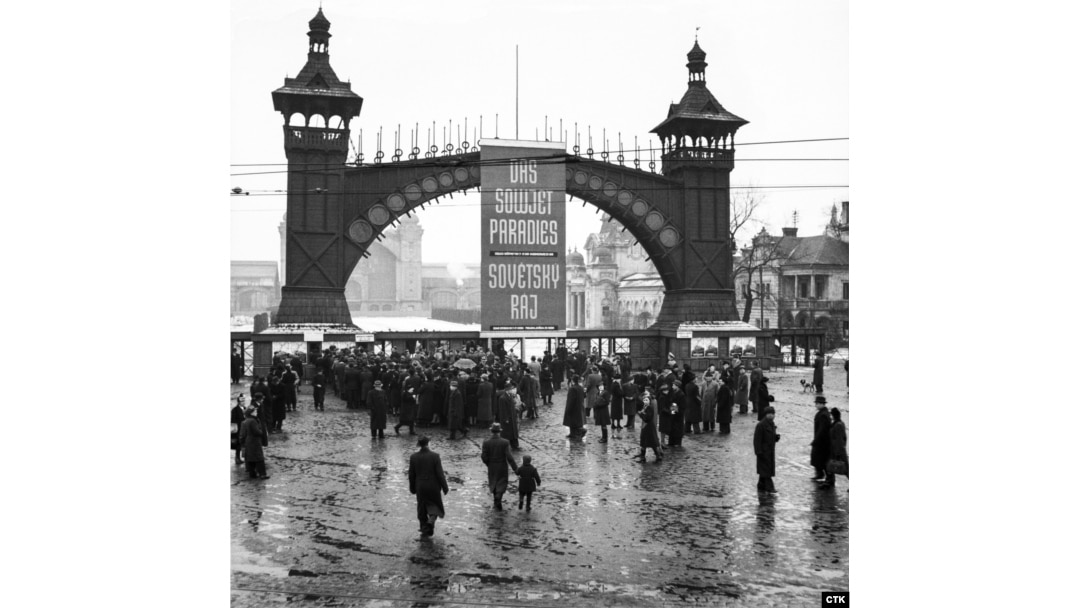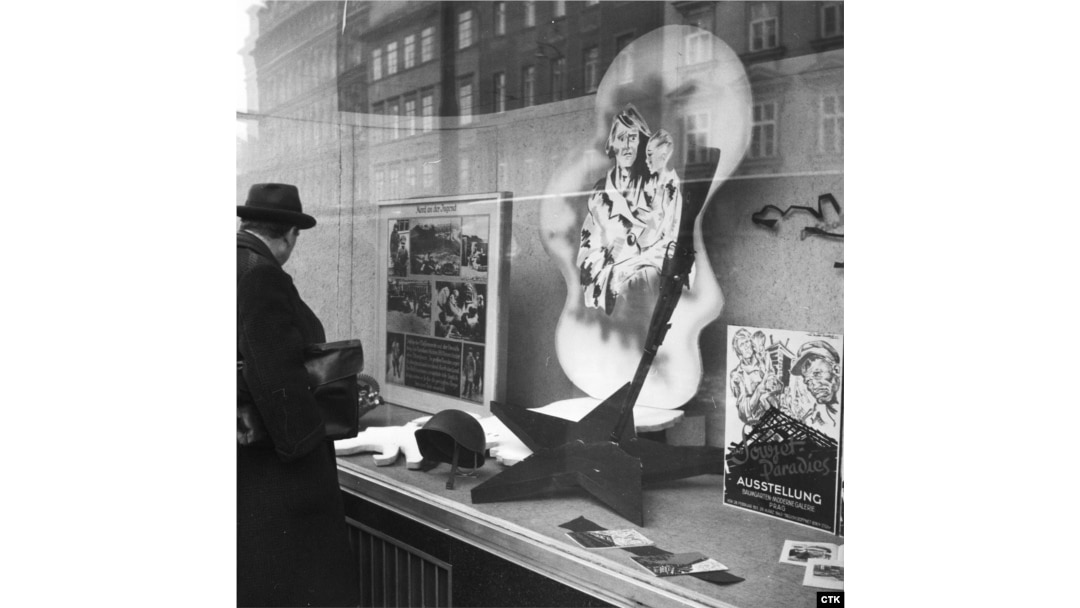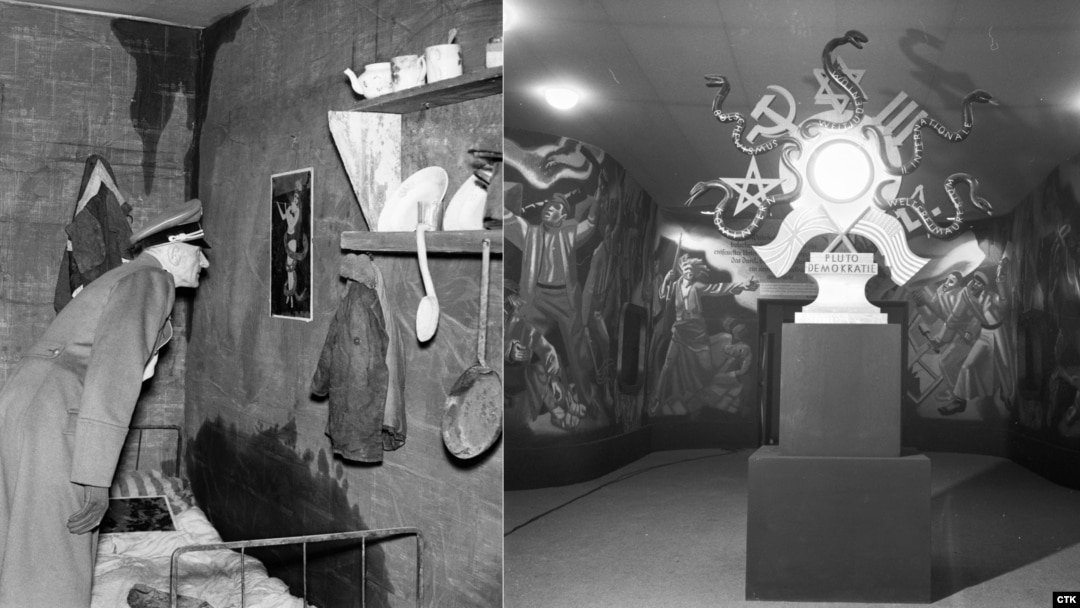
Crowds flock towards the “Sovetsky Raj” (Soviet Paradise) show at the Prague Exhibition Grounds on March 7, 1942.

A Prague shop front promoting the exhibition.
Occupied Prague at the time was ruled over by Reinhard Heydrich, one of the most ruthless Nazis of the Third Reich, who requested the exhibition’s transfer from Vienna to Prague.

Inside the exhibition, which was open to the public daily from 9 a.m. until 9 p.m. throughout March 1942, an entire village lane from Soviet territory had been transported from the fighting front and recreated to show the “gray misery” of life under Bolshevism.
The inside of a village shack at the exhibition.
At the time, German forces were several months into the invasion of the U.S.S.R., which the Nazi leadership hoped would end with the enslavement or annihilation of the Slavic population of the western part of the Soviet Union.
A monument in the exhibition seeking to link communism, Freemasonry, Judaism, and social democracy with Western powers.
The exhibition’s brochure claimed Jewish Bolsheviks in the Soviet Union had “exterminated the best elements of the East to make themselves the absolute rulers of an area from which they hoped to establish world domination.” Ironically, this was practically what the Nazi leadership itself planned for the region.
Nazi officers inspect a shack that appears to have had grease daubed on the walls to emphasize miserable Soviet living conditions.
The exhibition’s promotional brochure declared: “Everything that had been said about Bolshevism before the outbreak of the war with the Soviet Union has been thrown into the shadows by reality. Words and pictures are not enough to make the tragedy of Bolshevist reality believable to Europeans. This concurs with what our soldiers repeatedly say. It is impossible to portray conditions in the Soviet Union without oneself having seen and experienced them.”
A purported execution cell of the Soviet secret police.
The exhibition brochure claims: “The condemned were brought to the cell and shot in the back of the neck. The corpses were moved to the side and sprayed with a hose to wash away the blood. A fan provided fresh air so that the next victim would not faint from the blood, because he was to remain conscious until the last moment.”
A shack purportedly seized from the Belarusian Soviet Socialist Republic.
Konstantin Gerbeev, a Prague-based historian, says the Nazis' Prague exhibition largely backfired.
Visitors to the exhibition throng a captured Soviet artillery piece.
Gerbeev told RFE/RL, “The Czechoslovaks ignored the depictions of miserable living conditions but were enthusiastic about the Soviet military equipment.”
A Soviet KV-2 tank being transported to the exhibition.
Gerbeev says this formidable “fortress on wheels” created a sensation when it arrived in Prague and gave hope to many Czechoslovaks that the Nazis -- who had recently faced their first major setback in the battle for Moscow -- would soon be defeated.
Soviet posters on display inside the exhibition.
Both Nazi and communist regimes made extensive use of crude propaganda. Adolf Hitler described his vision for propaganda in 1925: “…all effective propaganda must be confined to a few bare essentials and those must be expressed as far as possible in stereotyped formulas. These slogans should be persistently repeated until the very last individual has come to grasp the idea that has been put forward.”
A stuffed “tank destroyer” dog on display at the exhibition.
The Soviet-trained animals, known as “mine dogs” by Nazi troops, were trained by their Red Army handlers by placing food under tanks, teaching them to associate the rumbling war machines with eating.
In battle, the hungry dogs were fitted with an explosive belt with a vertical “switch” that would detonate the explosives when the switch brushed the underside of an enemy tank.
Although several successful uses of the dogs were reported, one of the main flaws of the idea, besides its cruelty, was that German tanks used regular gasoline while the Soviet tanks the dogs were trained on used diesel. Many of the doomed animals reportedly ignored the strange-smelling Nazi tanks and instead created chaos when they ran off in search of diesel vehicles instead.
Nazi officers inspect a captured Soviet vehicle at the exhibition.
Hitler youth view a Soviet secret police cell at the exhibition in Berlin in May 1942.
After Prague, the exhibition was held in the German capital, where it was viewed by some 1.3 million people. Members of an underground anti-Nazi group reacted to the exhibition by putting stickers around Berlin declaring:
“Permanent Exhibition
The NAZI PARADISE
War Hunger Lies Gestapo
How much longer?”


